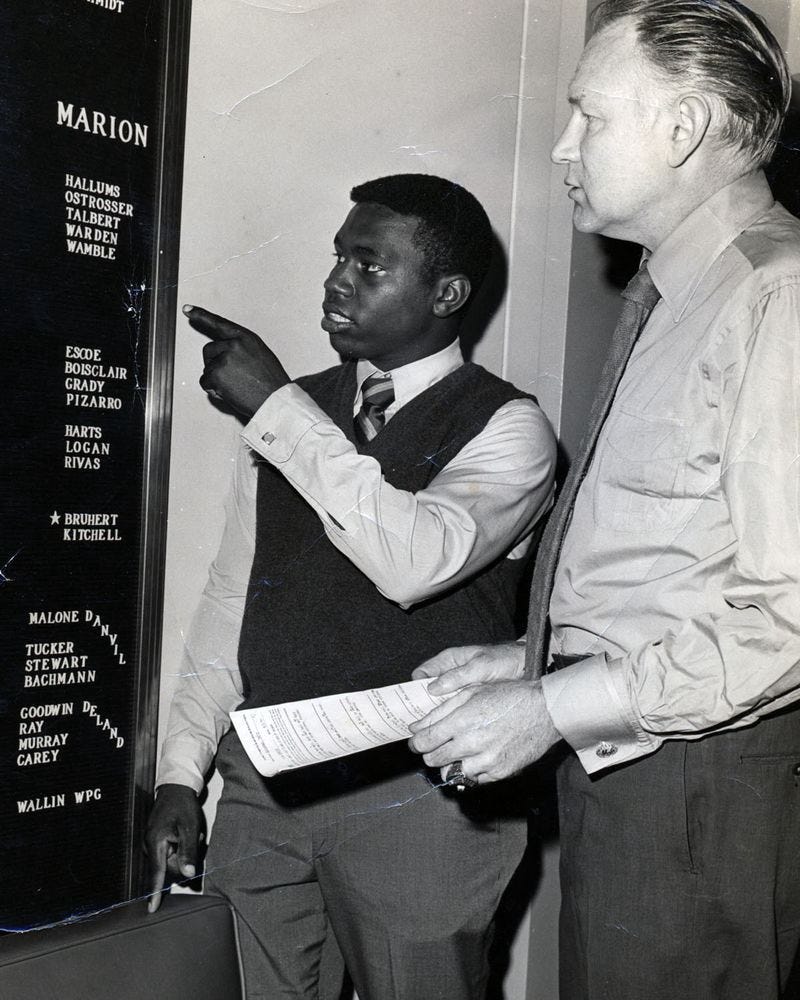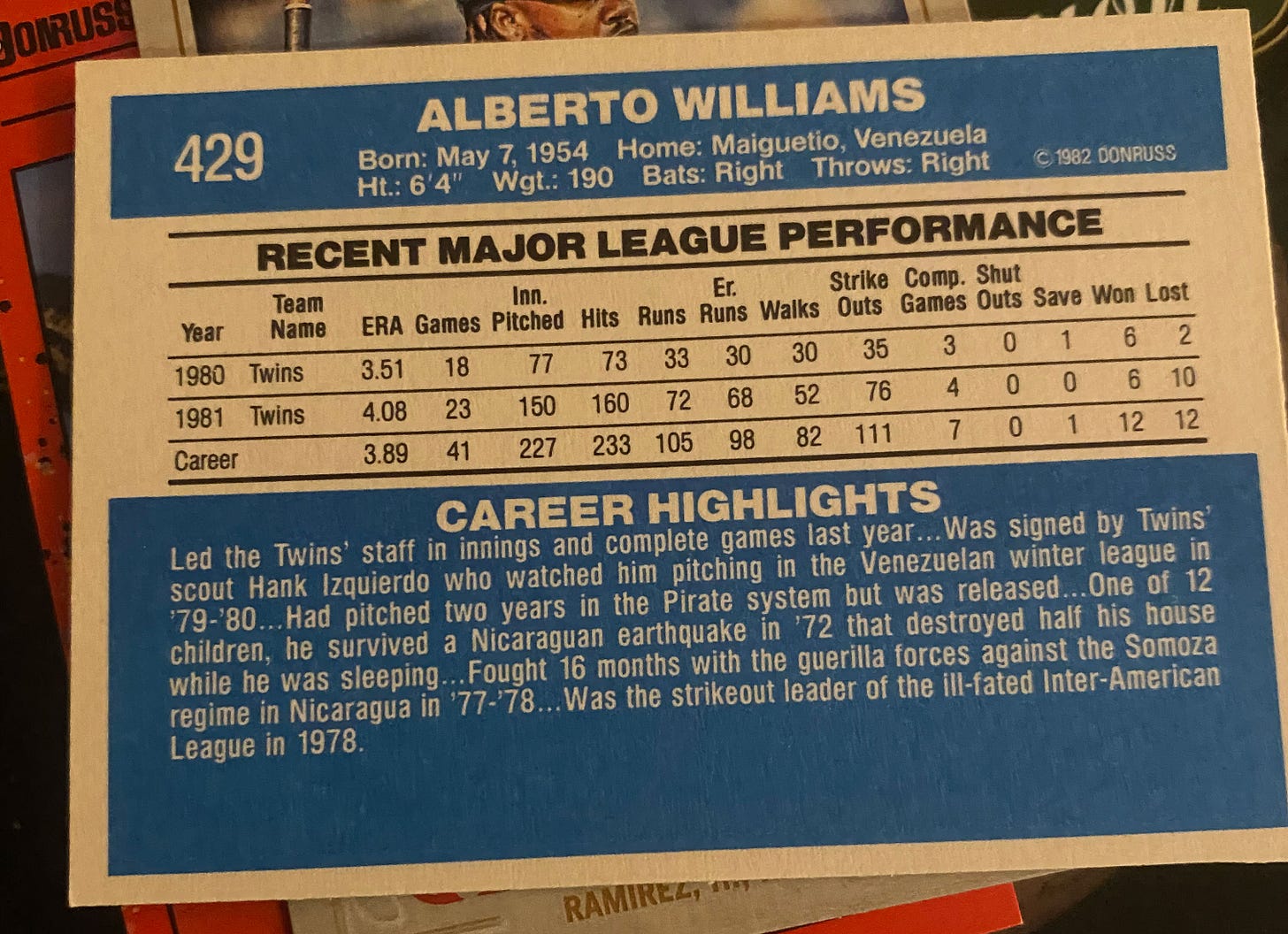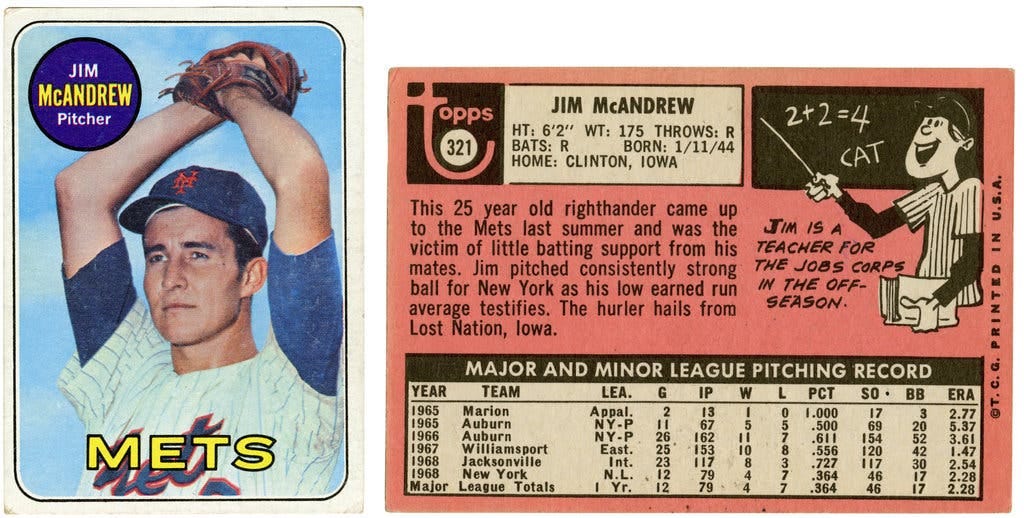Marion ‘is my second home,’ says the man who drafted Nolan Ryan
Beyond Marion: The things we learn from the backs of baseball cards
Marion Mets Substack – Issue 10
A few days before the holidays, I called Joe McDonald. Just out of the blue, I called the former general manager of the New York Mets.
I write this as if it's something unusual for me, but it’s not.
Most phone conversations I have about the Marion Mets begin with a cold call. Those calls begin with me quickly making my pitch for why the person on the other end should take a few minutes out of their day to talk to me… and not hang up the phone.
Each call is different, depending on who I’m calling, of course.
When I phoned McDonald, right away I told him my name, mentioned the person who gave me his number, the Marion Mets and the main reason I was calling, James Raymond Plummer.
With those few words I could sense him becoming at ease, like I had a chance.
“Oh, great, great man,” McDonald said of Plummer. “He was the best hire I ever made in my baseball career.”
That’s saying a lot.
Connect with Marion Mets Substack on Facebook
Before taking on the role as general manager of the New York Mets, McDonald served as the team’s minor league director. During his tenure with the Mets, and later with the St. Louis Cardinals and Detroit Tigers, he made numerous hires, signed thousands of ballplayers, and drafted Nolan Ryan, whom he sent to Marion, Virginia, to begin his pro baseball career.
My main reason for calling McDonald was to chat about Plummer because I had seen the two together in a photo looking over the Mets’ minor league rosters in 1970, including players assigned to Marion.

If you don’t know, Plummer grew up in Marion and began working as a bat boy for the rookie league Mets during the team’s inaugural season in 1965. He was there with Nolan Ryan and other future major-leaguers that year such as Jim Bibby, Jim McAndrew, Leroy Stanton and Steve Renko.
Through the next few years, Plummer did almost anything the team needed and soon became Marion’s general manager. Later, McDonald hired him to work for the big league Mets in New York City. He stayed there for more than 20 years until 2008 when he died of heart failure at the way-too-young age of 57.
“He kept pestering me to hire him full-time up in New York,” McDonald said. “I naturally would say to him, “James, you can’t make any money here. Utilize your education and get a job. Forget baseball.’”
However, Plummer “was so persistent that I finally said. ‘OK, here’s what we’ll do. You come up to New York, and you’re going to do anything and everything and work for anybody in order to justify your salary,’ which wasn’t much,” McDonald recalled. “I said, ''If Tommie Agee [New York Mets center fielder from 1968 to ‘72] needs to be rubbed down in the offseason, you will do it,’ James did it all. He could handle it all.”
McDonald, now 93 and living in Lakeland, Florida, shared with me many great stories about Plummer, which was why I called him. “The reason I gave you the time of day,” he told me,” was because I love James Plummer.”
But, I’m not writing Plummer’s story today. There still are way too many people I need to talk with. It’s coming soon, though. Perhaps mid-February. And, now that I think about it, I probably should have saved those anecdotes above for that story, but, after I talked with McDonald, I couldn’t wait to share some of his thoughts and memories.
His recollections included the most famous of all Marion Mets players, Lynn Nolan Ryan Jr.
“He went (was drafted) in the 12th round. Now, you can give me credit for drafting him, but internally I say, ‘What a mistake!’ I waited 12 rounds,” McDonald said in a humorous, self-deprecating manner. “Don’t paint me as a genius. Stupid me.”
We also chatted about Mike Jorgensen, whom the Mets drafted and sent to Marion in 1966. Jorgensen hit .313 and smacked 8 home runs and swiped nine bases in 46 games for Marion that year and went on to have a stellar major league career with the Mets, Montreal Expos, Oakland A’s, Texas Rangers, Atlanta Braves and St. Louis Cardinals.
Back then, in ‘66, it was the first baseman’s artful fielding that grabbed McDonald’s attention.
“His [Jorgensen] fielding was good enough where, I maintain, when he was 18, that he could play first base in the major leagues,” McDonald said. “His fielding was superb. He turned out to be a pretty good hitter, too.”
McDonald and I also chatted about how Marion, after years of trying to get a minor league team, successfully landed an affiliation with the New York Mets.
“I’ll tell you this. I’m the one who moved the club there,” McDonald said. “I wanted to get into the Appalachian League. I think it’s a good start for those young men.”
He liked Marion, but at first, he wasn’t sold on the ballpark and facilities.
“Was it an ideal facility? Of course not,” he said. “It was terrible in the sense that the clubhouse was a high school locker room, for God’s sake. Not ideal. And when you sign a player and you give them a lot of money and he’s been playing in college on beautiful fields and then he has to come to Marion,” – he chuckled – “It was not a wonderful, ideal facility.”
Anecdotes like these made me even more thankful that McDonald gave me time out of his day, 35 minutes to be exact. It was an opportunity to ask more questions about his long baseball career. About the players he scouted over the years, those he drafted and signed and sometimes watched get traded away.
His heart still breaks over the Nolan Ryan trade from the Mets to the Angels in December 1971.
The New York Times’ headline read: “Mets trade Ryan. No Kidding!” In its lead, the paper wrote, “The Mets finally gave up on Nolan Ryan's wandering fastball today.”
“When you’re a farm director and you start working hard to develop players and your player is traded,” McDonald said, “it hurts.”

Typically, when I Interview someone about their involvement with the Marion Mets, especially those who have had long baseball careers and experiences in a number of cities – McDonald retired from baseball just three years ago at age 90 – I have to redirect the conversation back to Marion. But, not this time. McDonald often steered our conversation back to Marion and the town’s long-gone ballclub.
“That’s my second home,” he said sincerely with the same excitement he spoke about Nolan Ryan’s fastball, Jorgensen’s footwork at first, and Whitey Herzog’s crosschecking scouting abilities.
“Naturally, those were my boys,’ he said of the Marion players. “I was the scouting director. I was director of player development. I was in charge. I had to go there [Marion] to see the players and to see how well the manager handled the players. As long as I had that responsibility, I naturally went to Marion.
“And, I loved it. I think it was the Virginia House I stayed in,” he recalled. “It was a quaint little town, and I enjoyed going there immensely.”
Several times throughout our chat, McDonald referred to Marion as “quaint.” And, when I told him I lived in Marion, he excitedly replied “Oh, my God,” as if he was reconnecting with part of his distant past.
“If you were born in New York City (as McDonald was), the contrast of Marion, Virginia is so great,” he said. “It’s so unlike the big city.”
Former New York Times writer Robert Lipsyte said the same thing a couple of years ago. He came to Marion in 1966 to write a feature on the big city Mets’ rookie league team – in just its second year of existence – and report on the progress of Jorgensen, who played high school ball just a hard-hit line drive away New York’s Shea Stadium.
“It was wonderful and charming,” Lipsyte told me in January 2021. “And, the people in Marion thought it was a privilege to have these ball players in their midst and to have the dream that some of them would some day make it to the big leagues and they would remember when they were just kids.”
I told McDonald about Lipsyte’s recollections.
“That’s so true. I always loved going to Marion because of the quaintness and the beauty of the people.”
When I called McDonald four days before Christmas, I wasn’t sure what to expect. I never know what’s going to happen on blind calls. Many times it’s a phone that keeps ringing. Occasionally it’s the wrong number. Sometimes it’s an amusing voicemail greeting. Looking at you, Jesse Hudson.
Once, I asked for someone and the reply on the other end was, “Yeah, that’s my father. He’s in Scotland. He might be back in a few months.”
Click!
But, getting a chance to talk with McDonald and hearing him speak so warmly about Marion and his frequent visits here in the 60s and 70s reminded me of why I do this research and why I’m out of bed at 2 in the morning writing stories.
It’s rewarding in so many ways to find and extract and put out into the world information that Google doesn't have access to yet. To relay stories about our hometown Marion Mets and those who were affiliated with those teams, like James Raymond Plummer, that otherwise will be lost to time.
As our conversation neared the end, I asked McDonald if I could call him back if I had follow-up questions.
There was a brief, awkward pause.
“I guess,” he said carefully. “Yeah, I’ll take it from you.”
Before we hung up, however, he left me with this weighty responsibility.
“Paint the right picture of the man when you write about James Plummer,” he said.”I haven’t forgotten him. I’ll never forget James Plummer.
Thanks, Joe. No pressure.
Beyond Marion…
The things we learn from the backs of baseball cards
Yesterday, my daughter walked downstairs and handed me a handful of baseball cards I had given her years ago. She had been using them for bookmarks, she confessed, and was ready to get them off her desk.
As I sifted through about 30 cards, scanning them front and back, I remembered something that had escaped me: You can learn a lot about a baseball player from his card, and it isn’t always about baseball.
A good example can be found on the back of Al Williams’ 1982 Donruss card. Under “Career Highlights,” among the stats and facts, we learn that Al, a Minnesota Twins pitcher from 1980 to ‘84, “survived a Nicaraguan earthquake in ‘72 that destroyed half his house while he was sleeping.”
That line itself sent me Googling for more information about the earthquake. The 6.3 magnitude quake struck near the capital city Managua about 30 minutes after midnight on December 23, 1972. Reports vary widely about how many people were killed, between 4,000 and 11,000. More than 20,000 were injured and 300,000-plus were left homeless. Al was 18 at the time of the earthquake. It was just a year after he began playing baseball.
The next line Donruss listed among the pitcher’s “Career Highlights,” said Al “fought 16 months with the guerilla forces against the Somoza regime in Nicaragua in ‘77-’78.” The next line tells us he “was the strikeout leader of the ill-fated Inter-American League in 1978.”
OK, that sentence seems a bit out of place. Let’s go back to Al fighting with guerilla forces.
According to an April 3, 1984, New York Times story, which quotes that year’s Minnesota Twins media guide, the Nicaraguan government would not grant Williams, then a minor leaguer for the Pittsburgh Pirates, a visa to leave the country to join his ball club in the United States in 1977, so “this prompted Al to sign up with the Sandinista National Liberation Front guerillas and he was engaged in jungle fighting against forces of Anastasio Somoza for the next 16 months.”
Times reporter Ira Berkow asked Al about about those months of fighting and his “cloak and dagger” escape – that’s the way the Twins media guide phrased it – from his home country.
“That’s in the past,” Al replied, sitting in front of his locker. “I live for the future.”
Three years prior, the Times wrote about “Fearless Al Williams” for a section titled “Sports People.” There, Al spoke briefly about the time he spent fighting and away from baseball.
“I really missed baseball the two years I was out of it,” he said, “but, I wasn’t thinking about baseball all the time. “I was just trying to stay alive.”
Do you remember reading baseball card backs in the 1970s and ‘80s and seeing “Marion” listed in the stats line? Here’s Jim McAndrew’s 1969 Topps New York Mets card. McAndrew pitched in Marion, as the card indicates, in 1965.
That’s all for now. But before you go, this is my weekly reminder that I’m always looking for stories about the Marion Mets. If you were a player, fan, ball boy, concession stand worker… anything… and have a story to share, I’d love to talk with you. You can reach me at chadoz97@gmail.com.





